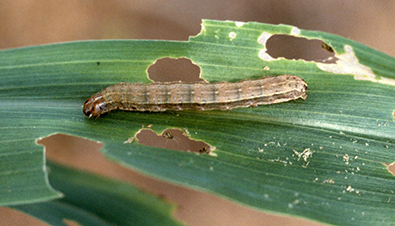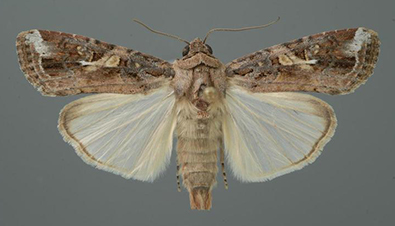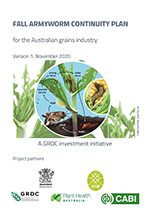Read the latest information on
Foot-and-mouth disease
An important part of Australia’s biosecurity system is to prepare for the arrival of exotic pests. Preparations are based on an understanding of pest biology, host range, global spread and management strategies used in other parts of the world.
This knowledge allows our biosecurity and agriculture departments to put in place processes that assist with the detection and first steps towards management of the pest, should it reach Australia.
When a new pest or disease is first detected – particularly if that occurs in an agricultural production area – a decision needs to be made whether it is feasible to eradicate it or whether we need to learn how to manage it.
This decision is made at a national level with input from the states and territories and the industries likely to be impacted by the pest, in a process that is set out in the Emergency Plant Pest Response Deed (EPPRD).

Fall armyworm larva. Image: John C. French Sr., Retired, Universities:Auburn, GA, Clemson and U of MO, Bugwood.org
The EPPRD is a legal agreement between the Australian Government, state and territory governments, Plant Health Australia and peak industry bodies that outlines the actions to be taken and the cost sharing arrangements for funding a response, should that be required.
When the decision is made that it is not feasible to eradicate a new pest, the pest is no longer considered to be ‘exotic’. It then becomes the responsibility of the state and territory governments and impacted industries to identify and support the research, development and extension (RD&E) that may be required to assist with the ongoing management of that pest.
A recent example of an exotic pest that was determined unfeasible to be eradicated was fall armyworm (FAW), which arrived in northern Australia in early 2020.

Fall armyworm adult moth. Image: Lyle Buss, University of Florida, Bugwood.org
The plant biosecurity system at the federal, state and territory levels was prepared for this type of scenario, which allowed immediate actions to be taken, including:
Each action is designed to provide the initial support that growers and advisors need to identify the pest and options available to control it, should they be required.
While these steps were being taken, the Grains Research and Development Corporation considered what RD&E investments would be appropriate to develop management options for FAW for the Australian grains industry.
 An important first step was to fund the development of a ‘continuity plan’ for FAW, which collated reliable information about the pests’ biology, behaviour and management in crops and environments overseas, to guide actions until local research could be completed.
An important first step was to fund the development of a ‘continuity plan’ for FAW, which collated reliable information about the pests’ biology, behaviour and management in crops and environments overseas, to guide actions until local research could be completed.
The steps undertaken following the arrival of FAW in Australia demonstrated that our system is working well.
The National Fall Armyworm Continuity plan is available from planthealthaustralia.com.au/fall-armyworm
Acknowledgement: reproduced from an article written by Bill Gordon, Grains Biosecurity Officer, NSW DPI, for Ground Cover magazine